Abstract
Purpose
Brain metastasis is the most common complication of brain cancer; nevertheless, primary lung cancer accounts for approximately 20%–40% of brain metastases cases. Surgical resection is the preferred treatment for brain metastases. However, no studies have reported the outcome of surgical resection of brain metastases from non–small-cell lung cancer (NSCLC) in the People’s Republic of China. Moreover, the optimal treatment for primary NSCLC in patients with synchronous brain metastases is hitherto controversial.
Patients and methods
We retrospectively analyzed the cases of NSCLC patients with brain metastases who underwent neurosurgical resection at the Sun Yat-sen University Cancer Center, and assessed the efficacy of surgical resection and the necessity of aggressive treatment for primary NSCLC in synchronous brain metastases patients.
Results
A total of 62 patients, including 47 men and 15 women, with brain metastases from NSCLC were enrolled in the study. The median age at the time of craniotomy was 54 years (range 29–76 years). At the final follow-up evaluation, 50 patients had died. The median OS time was 15.1 months, and the survival rates were 70% and 37% at 1 and 2 years, respectively. The median OS time of synchronous brain metastases patients was 12.5 months. Univariate analysis revealed that radical treatment of primary NSCLC was positively correlated with survival, and it was an independent prognostic factor in the multivariate analysis.
Conclusion
Surgical resection is an effective treatment for brain metastases. Besides craniotomy, radical therapy is necessary for the management of primary NSCLC in patients with synchronous brain metastases.
Introduction
Lung cancer is the most common cause of cancer-related death worldwide; it accounted for 13% (1.6 million) of the total diagnosed cancer cases and 18% (1.4 million) of total cancer-related deaths in 2008.Citation1 In the USA, it accounts for 26% and 28% of all cancer-related deaths among women and men, respectively.Citation2 Non–small-cell lung cancer (NSCLC), including its types adenocarcinoma, squamous cell carcinoma, large-cell carcinoma, and bronchioloalveolar carcinoma, accounts for nearly 85% of all lung cancer cases.Citation3 The risk of developing brain metastases is up to 10% for patients in the early stages of NSCLC.Citation4 Furthermore, brain metastasis occurs in 30%–50% patients with advanced NSCLC.Citation5,Citation6
The development of brain metastases is often considered as the terminal stage of any cancer, and the prognosis of patients with brain metastases from NSCLC is generally poor. Without treatment, the median survival time is only 1 month.Citation7 Whole-brain radiation therapy (WBRT) alone can extend the median survival time to 3–6 months.Citation8,Citation9 Two randomized control trials have reported that patients with extracranial primary cancer and single brain metastasis who underwent surgical resection followed by WBRT had longer survival time and better quality of life than did similar patients who underwent WBRT alone.Citation8,Citation10 Nevertheless, the median survival time of patients undergoing combination therapy is also not more than 1 year. Thus, management of brain metastasis continues to be a significant challenge in the treatment of NSCLC.
No studies have hitherto reported the outcomes of NSCLC patients in the People’s Republic of China who underwent surgical treatment for brain metastases in the People’s Republic of China. In the present study, we retrospectively analyzed the cases of patients with brain metastases from NSCLC who underwent neurosurgical resection at a single hospital, and assessed the efficacy of this treatment and the necessity of radical treatment for primary NSCLC in patients with synchronous brain metastases.
Materials and methods
Patients
We analyzed the cases of NSCLC patients who underwent craniotomy for brain metastases between January 2000 and June 2012 at Sun Yat-sen University Cancer Center. Brain metastases were diagnosed using magnetic resonance imaging (MRI), and serial MRI was used for follow up. Clinical parameters included patient demographics, number of brain metastases, location of brain metastases, tumor histology, treatment modality, and thoracic disease stage and treatment. Additionally, recursive partitioning analysis (RPA) was performed to facilitate stage classification.Citation11 Patients <65 years old with Karnofsky Performance Status (KPS) ≥70, controlled primary cancer, and no extracranial metastases were grouped under class 1. Class 3 included all patients with KPS <70. Patients not fitting any of the above-mentioned criteria were grouped under class 2. NSCLC stage was classified according to the seventh edition of the American Joint Committee on Cancer (AJCC) staging criteria,Citation12 excluding the metastases in the brain. Overall survival (OS) time was calculated as the duration between the time of diagnosis of brain metastases and death or the date of last follow up (November 2013) for patients who survived until the end of the analysis period. The study was approved by the ethics committee of Sun Yat-sen University Cancer Center.
Statistical analysis
Statistical analysis was performed using the SPSS v16.0 software (IBM Corp, Armonk, NY, USA). Survival data were analyzed by the Kaplan–Meier method and logrank test. The Cox proportional hazard model was used to identify the independent prognostic factors for survival. P<0.05 was considered as statistically significant.
Results
Patient demographics
A total of 62 patients, including 47 men and 15 women, with brain metastases from NSCLC were enrolled in the study. The median age at the time of craniotomy was 54 years (range 29–76 years). The histopathological subtype was adenocarcinoma in 50 patients, squamous cell carcinoma in eight patients, adenosquamous carcinoma in two patients, large-cell carcinoma in one patient, and bronchioloalveolar carcinoma in one patient. According to the NSCLC classification, 15 patients had stage I cancer, 19 had stage II cancer, and 28 had stage III cancer. Of these 62 patients, 49 had single brain metastasis, and 13 had two or more brain metastases. Only 22 patients had synchronous brain metastases from NSCLC. Synchronous presentation was defined as diagnosis of brain metastases within 2 months of diagnosis of NSCLC. According to RPA classification, 34 patients belonged to stage I; 20 belonged to stage II; and eight belonged to stage III. Patients’ characteristics are summarized in .
Table 1 Patient demographics
Management of brain metastases
All symptomatic patients diagnosed with brain metastases and presenting with brain edema received intravenous dexamethasone. All patients underwent craniotomy, of which 50 underwent complete resection. For patients with two or more brain metastases, only a single life-threatening brain lesion was excised. A total of 45 patients underwent metastasectomy followed by WBRT, whereas nine patients with multiple brain metastases underwent stereotactic radiosurgery (SRS) followed by metastasectomy. Eight patients underwent metastasectomy alone because of poor physical condition. The most commonly used fractionation schedule for WBRT was 30 Gy doses in 10 fractions. The median maximal and marginal doses for SRS were 36 Gy (range 32–40 Gy) and 18 Gy (range 14–24 Gy), respectively.
Management of lung cancer
Patients were considered to have had radical therapy if they underwent surgical resection and/or received sequential or concurrent chemoradiotherapy. Patients who received only chemotherapy for thoracic disease were considered to have had palliative thoracic therapy. A total 35 patients underwent lobectomy, eight underwent wedge resection, five underwent chemoradiotherapy, and seven patients only underwent chemotherapy. The various management approaches are summarized in .
Table 2 Management of lung cancer
Outcomes and survival analysis
Kaplan–Meier analysis and logrank test were used to identify potential predictive factors of survival. At the final follow-up visit, 50 patients had died. Of these, 21 patients died from the progression of brain metastases, and 29 patients died because of systemic metastasis. The median OS time was 15.1 months, with survival rates of 70% and 37% at 1 and 2 years, respectively ().
Figure 1 Kaplan–Meier analysis for overall survival of all patients.
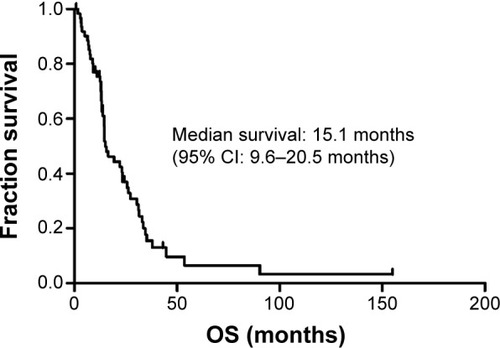
shows the results of the univariate analysis for the prognostic factors of OS for all patients. The stage of primary NSCLC correlated with OS, with a median OS time of 34.9 months for stage I patients, 19.2 months for stage II patients, and 9.0 months for stage III patients (). The RPA stage also correlated with OS, with a median OS of 23.4 months for stage I patients, 14.5 months for stage II patients, and 7.4 months for stage III patients (). In addition, absence of synchronous brain metastases was associated with longer survival (). The primary NSCLC (P<0.001) and RPA (P=0.001) stages were also independent prognostic factors in the multivariate analysis.
Figure 2 Kaplan–Meier analysis for overall survival by NSCLC stage.
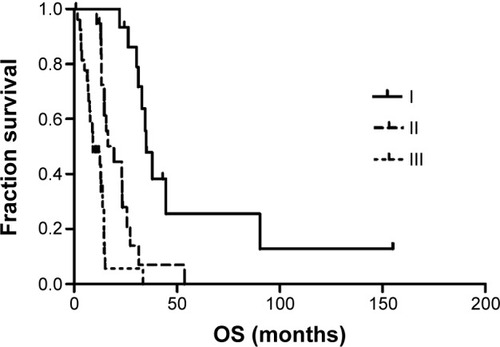
Figure 3 Kaplan–Meier analysis for overall survival by RPA classification.
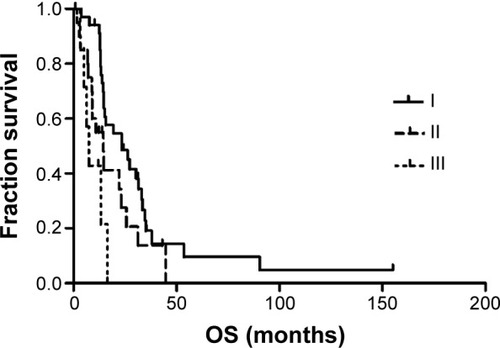
Figure 4 Kaplan–Meier analysis for overall survival of patients with synchronous and metachronous brain metastases.
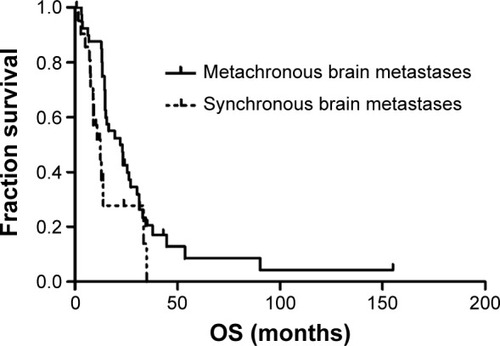
Table 3 Univariate analysis to identify factors affecting overall survival of patients with brain metastases
shows the results of the univariate analysis for prognostic factors of OS for synchronous brain metastases patients. The median OS time for patients with synchronous brain metastases was 12.5 months. In the univariate analysis, radical treatment of primary NSCLC was found to be positively correlated with survival (P=0.005) and was an independent prognostic factor in the multivariate analysis (P=0.007) ( and ). Stage I and II NSCLC patients achieved longer survival than stage III patients (P=0.020); however, NSCLC stage was not an independent prognostic factor in the multivariate analysis ().
Figure 5 Kaplan–Meier analysis for overall survival by type of treatment for primary NSCLC in patients with synchronous brain metastases.
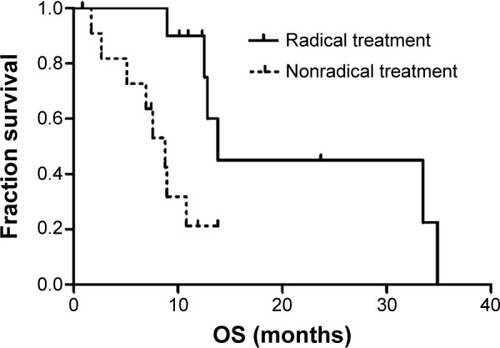
Table 4 Univariate analysis to identify factors affecting overall survival of patients with synchronous brain metastases
Discussion
Lung cancer burden in People’s Republic of China is continuously increasing because of an increased aging population, smoking habits, and air pollution. Brain metastasis is the most common complication of brain cancer; however, approximately 20%–40% of brain metastases originate from lung cancer.Citation13,Citation14 As the incidence rates for various cancers increases and mortality from cancers decreases, the incidence rates of brain metastases appear to be increasing.
Since 2000, our center has been the first in the People’s Republic of China to systematically treat brain metastases. Surgical resection followed by WBRT has become the standard management practice for brain metastases patients. In the present study, we retrospectively analyzed the cases of patients from a single center who underwent craniotomy for brain metastases from NSCLC. A median OS time of 15.1 months could be achieved for all patients, and the survival rates at 1 and 2 years were 70% and 37%, respectively. Consistent with published data,Citation8,Citation10,Citation15 we found that surgical resection could prolong survival and improve quality of life. Especially in patients with significant mass effect, surgical resection could relieve edema secondary to brain metastases and rapidly increase intracranial pressure to allow sufficient time for further treatment.
Low stages of primary NSCLC and RPA and absence of synchronous brain metastases were also associated with significantly longer survival times. However, there was no significant difference between the survival of single and multiple brain metastases patients. Of the 13 patients with multiple brain metastases, nine patients underwent SRS and four patients received chemotherapy followed by metastasectomy. They had a median OS time of 14.7 months. SRS offers a minimally invasive option to treat unresectable multiple brain metastases; therefore, patients with multiple lesions but a low total volume of disease can be treated with SRS.Citation16–Citation18 Nevertheless, surgical resection remains the primary approach for larger brain lesions that are accessible.Citation17,Citation19
The optimal treatment for primary NSCLC after aggressive management of brain metastases is hitherto controversial. Many studies have focused on the treatment of synchronous brain metastases from NSCLC.Citation20–Citation23 Lind et al suggested that radical thoracic treatment is acceptable for patients <65 years who are eligible to undergo surgery/radiosurgery for synchronous brain metastases from NSCLC.Citation20 Bonnette et al reported that after complete resection of a single brain metastasis, it is legitimate to proceed with lung resection.Citation22 Furthermore, Hu et al recommended aggressive treatment of the primary lung cancer, particularly for stage I NSCLC patients with single brain metastasis.Citation21
Consistent with these studies, we found that patients who received radical treatment of primary NSCLC had a significantly longer OS (13.8 months) than did those receiving nonradical treatment (8.7 months). In addition, stage I and II NSCLC patients (34.9 months) had a significantly longer survival than did stage III patients (8.9 months). Thus, radical treatment was necessary for certain patients who could undergo sequential or concurrent chemoradiotherapy for primary NSCLC.
The present study had certain limitations. First, some selection bias could have been introduced because of the low sample size, and additional studies using a large sample size are necessary to substantiate the findings of our study. Second, the effect of chemotherapy could not be assessed because of the heterogeneous chemotherapy courses employed in our patients. Prospective clinical trials employing a standardized chemotherapy course will be required to evaluate the effect of chemotherapy on prognosis.
In summary, the findings of our study suggest that surgical resection is an effective treatment for brain metastases from NSCLC. With the establishment of novel neurosurgical techniques, neurosurgery could provide diverse treatment options for brain metastases. Moreover, radical therapy for primary NSCLC is necessary in addition to craniotomy for patients with synchronous brain metastases patients.
Acknowledgments
This work was supported by the Wu Jieping Medical Foundation [grant number 320675012373]; The Science and Technology Planning Project of Guangdong Province, China [grant number Z012B031800382]; National Natural Science Foundation of China [grant number 81401908].
Disclosure
The authors report no conflicts of interest in this work.
References
- JemalABrayFCenterMMFerlayJWardEFormanDGlobal cancer statisticsCA Cancer J Clin2011612699021296855
- SiegelRNaishadhamDJemalACancer statistics, 2013CA Cancer J Clin2013631113023335087
- RamalingamSSOwonikokoTKKhuriFRLung cancer: New biological insights and recent therapeutic advancesCA Cancer J Clin20116129111221303969
- HubbsJLBoydJAHollisDChinoJPSaynakMKelseyCRFactors associated with the development of brain metastases: analysis of 975 patients with early stage nonsmall cell lung cancerCancer2010116215038504620629035
- MamonHJYeapBYJännePAHigh risk of brain metastases in surgically staged IIIA non-small-cell lung cancer patients treated with surgery, chemotherapy, and radiationJ Clin Oncol20052371530153715735128
- HsiaoSHChungCLChouYTLeeHLLinSELiuHEIdentification of subgroup patients with stage IIIB/IV non-small cell lung cancer at higher risk for brain metastasesLung Cancer201382231932324018025
- LagerwaardFJLevendagPCNowakPJEijkenboomWMHanssensPESchmitzPIIdentification of prognostic factors in patients with brain metastases: a review of 1,292 patientsInt J Radiat Oncol Biol Phys199943479580310098435
- PatchellRATibbsPAWalshJWA randomized trial of surgery in the treatment of single metastases to the brainN Engl J Med199032284945002405271
- MintzAHKestleJRathboneMPA randomized trial to assess the efficacy of surgery in addition to radiotherapy in patients with a single cerebral metastasisCancer1996787147014768839553
- VechtCJHaaxma-ReicheHNoordijkEMTreatment of single brain metastasis: radiotherapy alone or combined with neurosurgery?Ann Neurol19933365835908498838
- GasparLScottCRotmanMRecursive partitioning analysis (RPA) of prognostic factors in three Radiation Therapy Oncology Group (RTOG) brain metastases trialsInt J Radiat Oncol Biol Phys19973747457519128946
- EdgeSBByrdDRComptonCCFritzAGGreeneFLTrottiAAJCC cancer staging manual7th edNew York, NYSpringer2010
- KaalECNiëlCGVechtCJTherapeutic management of brain metastasisLancet Neurol20054528929815847842
- Barnholtz-SloanJSSloanAEDavisFGVigneauFDLaiPSawayaREIncidence proportions of brain metastases in patients diagnosed (1973 to 2001) in the Metropolitan Detroit Cancer Surveillance SystemJ Clin Oncol200422142865287215254054
- MuacevicAWowraBSiefertATonnJCSteigerHJKrethFWMicrosurgery plus whole brain irradiation versus Gamma Knife surgery alone for treatment of single metastases to the brain: a randomized controlled multicentre Phase III trialJ Neurooncol200887329930718157648
- FriedmanWAExpanding indications for stereotactic radiosurgery in the treatment of brain metastasesNeurosurgery201360Suppl 1S9S12
- BaschnagelAMMeyerKDChenPYTumor volume as a predictor of survival and local control in patients with brain metastases treated with Gamma Knife surgeryJ Neurosurg201311951139114423971958
- MohammadiAMRecinosPFBarnettGHRole of Gamma Knife surgery in patients with 5 or more brain metastasesJ Neurosurg2012117SupplS5S12
- YangHCKanoHLunsfordLDNiranjanAFlickingerJCKondziolkaDWhat factors predict the response of larger brain metastases to radiosurgery?Neurosurgery2011683682690 discussion 69021311296
- LindJSLagerwaardFJSmitEFPostmusPESlotmanBJSenanSTime for reappraisal of extracranial treatment options? Synchronous brain metastases from nonsmall cell lung cancerCancer2011117359760520872880
- HuCChangELHassenbuschSJNonsmall cell lung cancer presenting with synchronous solitary brain metastasisCancer200610691998200416572401
- BonnettePPuyoPGabrielCGroupe ThoraxSurgical management of non-small cell lung cancer with synchronous brain metastasesChest200111951469147511348955
- LeeDHHanJYKimHTPrimary chemotherapy for newly diagnosed nonsmall cell lung cancer patients with synchronous brain metastases compared with whole-brain radiotherapy administered first: result of a randomized pilot studyCancer2008113114314918459180
